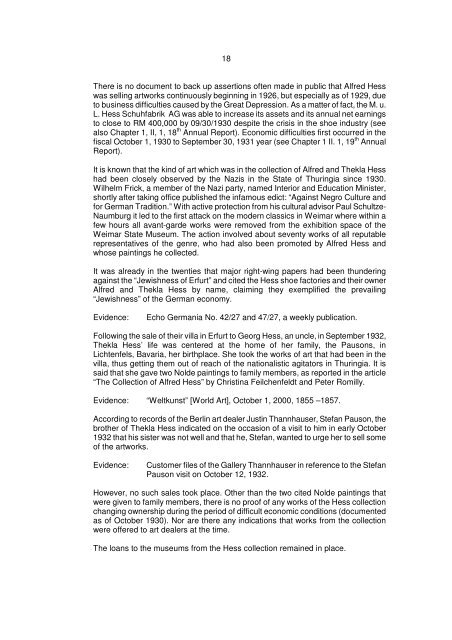Expert Opinion - Nazi Looted Art
Expert Opinion - Nazi Looted Art
Expert Opinion - Nazi Looted Art
Create successful ePaper yourself
Turn your PDF publications into a flip-book with our unique Google optimized e-Paper software.
18<br />
There is no document to back up assertions often made in public that Alfred Hess<br />
was selling artworks continuously beginning in 1926, but especially as of 1929, due<br />
to business difficulties caused by the Great Depression. As a matter of fact, the M. u.<br />
L. Hess Schuhfabrik AG was able to increase its assets and its annual net earnings<br />
to close to RM 400,000 by 09/30/1930 despite the crisis in the shoe industry (see<br />
also Chapter 1, II, 1, 18 th Annual Report). Economic difficulties first occurred in the<br />
fiscal October 1, 1930 to September 30, 1931 year (see Chapter 1 II. 1, 19 th Annual<br />
Report).<br />
It is known that the kind of art which was in the collection of Alfred and Thekla Hess<br />
had been closely observed by the <strong>Nazi</strong>s in the State of Thuringia since 1930.<br />
Wilhelm Frick, a member of the <strong>Nazi</strong> party, named Interior and Education Minister,<br />
shortly after taking office published the infamous edict: “Against Negro Culture and<br />
for German Tradition.” With active protection from his cultural advisor Paul Schultze-<br />
Naumburg it led to the first attack on the modern classics in Weimar where within a<br />
few hours all avant-garde works were removed from the exhibition space of the<br />
Weimar State Museum. The action involved about seventy works of all reputable<br />
representatives of the genre, who had also been promoted by Alfred Hess and<br />
whose paintings he collected.<br />
It was already in the twenties that major right-wing papers had been thundering<br />
against the “Jewishness of Erfurt” and cited the Hess shoe factories and their owner<br />
Alfred and Thekla Hess by name, claiming they exemplified the prevailing<br />
“Jewishness” of the German economy.<br />
Evidence: Echo Germania No. 42/27 and 47/27, a weekly publication.<br />
Following the sale of their villa in Erfurt to Georg Hess, an uncle, in September 1932,<br />
Thekla Hess’ life was centered at the home of her family, the Pausons, in<br />
Lichtenfels, Bavaria, her birthplace. She took the works of art that had been in the<br />
villa, thus getting them out of reach of the nationalistic agitators in Thuringia. It is<br />
said that she gave two Nolde paintings to family members, as reported in the article<br />
“The Collection of Alfred Hess” by Christina Feilchenfeldt and Peter Romilly.<br />
Evidence: “Weltkunst” [World <strong>Art</strong>], October 1, 2000, 1855 –1857.<br />
According to records of the Berlin art dealer Justin Thannhauser, Stefan Pauson, the<br />
brother of Thekla Hess indicated on the occasion of a visit to him in early October<br />
1932 that his sister was not well and that he, Stefan, wanted to urge her to sell some<br />
of the artworks.<br />
Evidence: Customer files of the Gallery Thannhauser in reference to the Stefan<br />
Pauson visit on October 12, 1932.<br />
However, no such sales took place. Other than the two cited Nolde paintings that<br />
were given to family members, there is no proof of any works of the Hess collection<br />
changing ownership during the period of difficult economic conditions (documented<br />
as of October 1930). Nor are there any indications that works from the collection<br />
were offered to art dealers at the time.<br />
The loans to the museums from the Hess collection remained in place.


